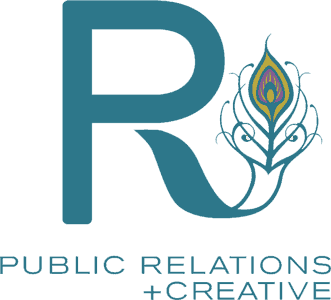R Public Relations Firm
Our Team's 2025 New Year's Resolutions
As 2024 ends, everyone is making New Year’s resolutions that can help guide them through 2025 toward their goals for the year. And we’re no different here at R Public Relations. A brief look back at 2024 shows a year of growth and amazing opportunities for us. We R proud to have racked up a long list of awards and participated in national press, taking R business to the next level.

New departments were developed within R team, including a culture squad and a marketing team, and we welcomed R first client and a team member from the UK.
After a fantastic year full of change and opportunity, we’re excited to look ahead at R New Year’s resolutions for 2025 and how they’ll help shape R future!

Growing R Presence in R Favorite Industries
The world of public relations (PR) is vast. There are all manner of industries that benefit from working with a PR team like Rs. We have clients in many industries, including business, technology, nonprofits, and retail. Meaningful partnerships in all of these industries allow us to help grow and maintain brands that align with R team’s own passions.
As we look to 2025, one industry in which we plan to boost R presence is the travel industry. Travel is more publicized than ever before, from travel TV shows and YouTube to influencers. And with travel volume expected to only grow in the coming year, we want to step in to fill a gap in travel PR to ensure that brands R able to reach experience-motivated individuals in the right ways.
Expanding R Client Base
A new year means new growth for most businesses—including Rs. Throughout next year, we’ll be working to expand R client base in several different ways. This includes bringing on both U.S.-based and international clients across industries that are looking for bold and clear branding.
With the expected growth of small businesses and the upcoming generation of business owners in Generation Z, we’re looking forward to bringing on new clients throughout 2025 who are seeking a trusted and creative PR partnership that’s in line with their goals.
Leaning into R Strengths
R New Year’s resolutions would be incomplete without touching on the strengths of R team. As a PR firm, we know exactly what we bring to the table for every client we work with—from highly personalized client work to a team-wide passion for the work we do.
But R strengths don’t stop there. In 2025, we’ll continue to nurture R positive workplace environment by allowing R intentional communication and creativity to guide R work. With the internal development of R team over the last year, maintaining a positive environment not only empowers R team but also allows us to continue R best work in making your business R business.
As a one-stop shop for all of R clients' needs, we’ll continue to provide high attention to detail and create campaign approaches that meet and exceed each client's expectations.
For expert PR help in 2025, reach out to R team for more information.
The Beauty of a Brand Audit for Strategic Planning
In the words of Steve Forbes, Chairman and Editor-in-Chief of Forbes Media, "Your brand is the single most important investment you can make in your business." An organization's brand is a holistic representation of all it is and all it hopes to be.
One crucial, time-tested way to examine these communicated and perceived messages and their impact on the organization and its public perception is by conducting a brand audit. This evaluation can be a tool for all businesses, small or large, to ensure that stakeholders and key audiences receive and interpret their goals as intended.
Accordingly, the information included in these audits is critical for the organization's broader vision and strategic planning.
What is a brand audit?
Before we discuss how a brand audit can strengthen strategic planning efforts, it's necessary to understand what it is and what it is composed of.
According to Indeed, "A company uses a brand audit to evaluate how its brands or products are positioned in its markets. Brand positioning is how a customer recognizes or recalls your brand and where your brand fits in an overall market. The audit reviews data to identify areas where your company can improve its brand's positioning and overall performance."
An audit can include a vast array of information, but its purpose is always to assess the brand's identity, strengths, weaknesses, opportunities, threats and goals.
At R Public Relations (RPR), our brand audits are comprised of numerous diverse components, including mood boards, tone and marketing assessments, SWOT analysis, value propositions, target audience personas, stakeholder analysis, key trends and timelines.
When developing client audits, we ensure that our findings speak to the brand's visual identity, mission, tone, alignment with audience expectations, perception from customers and of competitors and consistency across all communication channels.

Importance of a brand audit
This data is what makes a brand audit so impactful and dynamic.
Today, industries and markets worldwide face an increasing number of competitors and an influx of noise with the potential to muddy messaging and make brands of interest more difficult to find.
Offering top-of-the-line products and services is no longer enough. To truly make an impact, organizations must ensure their branding is clear, consistent and impactful, and brand audits are the optimal way to accomplish this.
According to Aprimo, the research conducted for a brand audit mindfully explores the brand's position in the market, allows a company to assess, enhance and elevate its messaging, and covers all aspects of the brand experience. This allows a brand to uncover its strengths and weaknesses, clarify its identity, develop a competitive advantage, digest customer insights, evaluate market trends and strengthen its strategic planning.
Bolstering strategic planning efforts
Of the benefits a brand audit presents, its ability to inform, streamline and enhance an organization's success strategies is most important.
Within the strategic planning process, a brand audit can provide insight that guides development, marketing and audience engagement decisions. Furthermore, it clarifies the organization's direction and consistency among team members and help set measurable growth goals. It ensures all actions are aligned in purpose and process and expose weaknesses or gaps in the brand preemptively.

One example of an organization effectively using a brand audit to inform its strategic planning is Coca-Cola. The beverage giant audited ever-evolving consumer preferences and market trends, revealing a developing desire for healthier options within the beverage industry. In response, Coca-Cola set its sights on diversifying and expanding its products to feature more health-conscious options like Coca-Cola Zero Sugar and Diet Coke.
Decisions such as this can help businesses remain relevant despite the dynamic desires of modern consumers.
Without conducting brand audits, organizations would be less capable of proactively identifying these threats and opportunities and may instead need to respond to changing markets reactively.
The more precise insights, brand alignment and marketing strategies an audit can produce are invaluable as they're the tools that enable organizations to position themselves for long-term success.
For more information on how your organization can benefit from a brand audit, schedule a meeting with RPR today, where R business is your business.
R Public Relations Firm’s Favorite Things Under $50: A Gift Guide from Publicists, Content Writers, and Marketers
The holiday season is upon us, and if you're a publicist, content writer, or marketer, you know how important it is to stay organized, inspired, and, of course, caffeinated. Whether you're looking to give something thoughtful to a colleague or need a little something for yourself, we've put together a list of our favorite things under $50 that make life a little easier, a little more fun, and, most importantly, more productive.
Here are R top picks—perfect for any public relations professional, marketer or content creator!
S'well Water Bottle – $25–$40

Move over Stanley, S’well is the new cool when it comes to staying hydrated. This Peacock blue is inspired by R logo and is also the key to staying productive, as the S'well bottle helps keep your water cold (or coffee hot) for hours. With its sleek, minimalist design and insulation technology, this water bottle will keep you refreshed as you power through your to-do list.
Why we love it: As busy marketers and PR pros, we’re always on the go, and having a high-quality water bottle that doesn’t sweat or leak is a game-changer. Plus, it’s eco-friendly!
Rahm Roast Coffee and Frother – $49.99

Every content creator, marketer, and PR professional knows that caffeine is the lifeblood of productivity. A cold brew coffee kit makes a fantastic gift for anyone who loves their coffee strong, smooth, and easy to make. Whether you’re gifting it to a colleague or adding it to your own holiday wish list, these kits make it easy to prepare coffee like a pro.
Why we love it: No more waiting in line for overpriced coffee—just brew your own, save money, and get back to writing your next press release.
“Steal Like an Artist” by Austin Kleon $10–$15

As professional writers, we love books, and these books are a must-read for any creative professional. Austin Kleon’s “Steal Like an Artist” is filled with actionable tips, creative exercises, and inspiring words to help you think outside the box. Whether you’re a publicist, writer, or marketer, this book will help you unlock your inner creativity and boost your productivity.
Why we love it: It's short, sweet, and full of practical advice that can help you take your work to the next level.
Bath Bombs & Candles – $15–$30

All work and no relaxation can lead to burnout. A set of luxurious bath bombs or a beautifully scented candle is a great way to help your PR colleagues relax after a long day of hustle. Look for natural ingredients and calming fragrances to create a spa-like atmosphere at home. Our latest obsession is Jo Malone, perhaps because we just opened the R UK office this year and want all things London!
Why we love it: Every publicist, writer, and marketer needs a little time to unwind, and this is the perfect way to indulge in some self-care.
CordBrick – $9.99

Creative professionals continuously manage multiple projects and devices at once. Plus, we know you’re always running around, so this keeps all cords and chargers handy and organized, even while traveling, working remotely, or heading into a Zoom meeting!
Why we love it: This compact solution keeps R cords organized and tangle-free. Ideal for anyone on the go!
VentaPak – $39.99

Marketers and PR pros are always on the go and need to have your handy laptop to work, but we don’t want the strain on our back! And this product works perfectly, whether traveling or working remotely, to avoid pain and also sweat since we need to always look glam!
Why we love it: This backpack spacer is so great its benefits bear repeating—more airflow and less strain. Plus, not only is it ideal for work, but it’s also perfect for hikers, travelers, or commuters! R team loves a good multi-use product!
Bowmar Nutrition Protein Powder – $49.99

R client and co-founder of Bowmar Nutrition, Sarah Bowmar, recently told us that the majority of women are protein deficient. Protein does so much good for your body, and an easy way to stick to those macros is by adding supplements like protein powder to your diet. A common misconception is that only “gym people” drink it, but it’s for anyone! It makes it even easier when companies like Bowmar Nutrition make it in so many yummy flavors like hot chocolate, blueberry cheesecake and peach cobbler.
Why we love it: As a team of mostly women, it’s important to prioritize our health. It’s easy to get caught up with client calls, emails and pitching, so having an easy source of protein to whip into coffee, smoothie, or alone as a shake can keep you feeling full for longer and improve your energy.
Le Creuset Wine Cooler Sleeve – $30

Le Creuset is best known for its Dutch ovens, but one of its sleeper products is wine cooler sleeves. Store it in your freezer and pop it over your favorite bottle of wine, and then you’ll be able to enjoy a perfectly chilled glass in only 30 minutes! Office happy hour, anyone?
Why we love it: After an awesome day of client connection and securing press, sometimes a glass of vino is the perfect way to celebrate. If you gotta chill a bottle on the fly, this is the solution!
Quince 100% Organic Cotton Oversize Cardigan – $49.90

This cardi from Quince is super comfy and cozy, perfect for those cooler winter months or that unusually cold workspace. Made with 100% organic cotton and in 11 different colors, its dropped shoulders and billowy sleeves make being comfortable at work fashionable.
Why we love it: It’s perfect for staying warm while in the office or effortlessly elevating your WFH Zoom outfit.
Aesop Resurrection Aromatique Hand Balm – $30

Everyone loves a luxurious hand balm, but when you’re constantly typing away at your computer or taking handwritten notes, it’s a necessity. This balm from Aesop is part skin-softening cream and part aromatic experience. Hydrate your hand while also enjoying relaxing, soothing scents.
Why we love it: Its grease-free formula keeps your laptop keys clean, and its delightfully citrus, woody, herbaceous scent makes it a nice pick-me-up!
Peepers Blue Light Glasses – $22

Fashion meets function with these chic blue light glasses from Peepers that are perfect for long days at work. They have a variety of different frames on their website, but these bold tortoise shells ones with bright blue highlights were calling R names. These are also sustainably crafted from recycled material, so you can feel good buying them. Plus, Oprah is a big fan of these!
Why we love it: We’re constantly staring at our screens, so any way we can reduce digital eye strain, stop headaches, and alleviate tired eyes, we’re game. The fun frames are just a bonus.
Scentbird – $9-17 (monthly subscription)

There are many aspects to putting your best foot forward as a marketer or PR pro, and we think scent is one of them! Scentbird offers luxury perfume brands at a minimal fraction of the price through a monthly subscription plan. The perfumes are designed to last for 30 days of use, but customers can choose to receive a new mini fragrance every month or bi-monthly.
Why we love it: Fragrances are a part of R personal styles and vibes. They play a role in how we present ourselves. Scentbird gives you an opportunity to have consistent variety in this niche aspect of your personal style and discover the scent notes that work best for you.
Cinnamon Project Incense – $40

This Cinnamon Projects incense has notes of carnation, leather, patchouli, and tobacco, creating a warm scent to fill your workspace or home. It brings such warm, woodsy vibes, which is a perfect combination with the incoming cold weather and cozy holidays.
Why we love it: R new office in Wedgewood Houston actually uses this incense! R team loves any opportunity to create a cozy atmosphere!
Colorful Hand-Blown Wine Glasses - Set of 6 – $39.99

Upgrade the office breakroom with these glasses, which come in six eye-catching colors that are sure to bring a pop of excitement to any gathering. Not only do the distinct shades make for a fun and playful atmosphere, but they also make it easy to keep track of which glass belongs to each individual. With a variety of unique hues to choose from, you can select your favorite color and relish all of life's colorful moments.
Why we love it: Whether you’re hosting a weekend dinner party or unwinding after a whirlwind day at the office, sometimes wine, cocktails or mocktails in a fun glass make all the difference! Treat yourself, and cheers to being a fabulous publicist!
Yeti Rambler – $40

Practicality and reliability are the mainstays of this water bottle. At 26oz, it’s large enough to last the average person throughout the day while still not being so large that it’s a hassle to lug around in and out of the office. Not only that, but the insulation on these bottles is top-notch and lasts all day!
Why we love it: For those with a busy schedule, it's very easy to put the needs of the body on the back burner to finish off those pesky to-do lists. Carrying around this Yeti Rambler just makes it that much easier to get the daily water intake that we need!
Thin Wild Mercury Fragrance Set – $30

Born in the Los Feliz Village area of Los Angeles, Thin Wild Mercury hosts a carefully curated line of fine fragrances. Each scent was designed to transport you into a particular cultural era in Los Angeles and New York. Thin Wild Mercury’s scents aren’t overbearing, but they are long-lasting and sure to add a sunshine-esque warmth to any space.
Why we love it: Whether it’s time to close R laptops and rest or increase R creativity, we love how the environment around us, whether sight, scent or sound, can significantly impact focus, mood and mental clarity.
Quilted Daydreams Softcover Spiral Lined Notebook – $34

Ethically sourced and plastic-free, Papier believes, "Stationary is more than pen and paper." The brand carries various designs and products guaranteed to delight every recipient. This unique product is a daily staple, encouraging individuals to brainstorm their next brilliant idea or reach for their goals.
Why we love it: There are few things better than a shiny, new notebook! While most have ample access to laptops, tablets and cellphones, there is something special about putting pen to paper.
Ranger Station Nashville Candle – $39

The Nashville candle mixes southern roots with the undercurrent of the city’s creative energy and identity. Our experience of Nashville is complex, and so is this scent, combining southern staples like magnolia and dogwood with classic elements of amber and musk. It smells like a late summer night on the porch, under the lights, trying to escape the humidity, dreaming out loud with the friends who’ll be there for you in every venture. This candle is an 8 oz. premium soy wax blend that’s poured and packaged by hand in Nashville, TN, and has a 30+ hour burn time.
Why we love it: We love supporting a local Nashville business. It is non-toxic and reminds us of working with fellow colleagues in the Nashville office even when we’re apart.
These gifts not only make perfect stocking stuffers or unique presents for publicists, marketers and content creators but also for friends and family who appreciate practical, thoughtful products. Happy gifting! 🎄✨
How Marketing and PR Can Support Each Other
People often think that marketing and public relations (PR) have a sort of frenemy relationship dynamic where they compete for the same goals. That is actually far from the case. Marketing and PR are like opposite sides of the same coin, with their own methods and strategies that are both designed to help brands succeed.

What Exactly is the Difference between Marketing and PR?
So, where is the distinction between marketing and PR? It all comes down to their respective goals and the strategies used to reach them. Take PR, for example. In PR, the goal is to shape consumer perception regarding the brand, build up their credibility and foster relationships within the community. We do this by reaching out and creating partnerships with influencers, event sponsorships, storytelling through media coverage and community engagement events.

This, of course, differs from marketing, as the goal is to create leads, improve ROI and ultimately help increase sales. This is done by utilizing SEO (Search Engine Optimization), crafting engaging social media campaigns, creating quality content that can be used on multiple platforms, and curating effective email marketing campaigns, to name just some of the types of marketing avenues commonly used. Each of these campaign strategies aims to place the brand in front of its target audience and convert them to customers.
Why Should You Focus On Both?
After learning the differences between marketing and PR, some people often think that they only need one or the other to take their brand to the next level. However, by just focusing on one rather than both collectively, you are missing out on an even greater potential. When you have an effective marketing and PR approach, the two work in tandem to craft a favorable public perception that holds credibility within the community while simultaneously promoting products or services that meet your target audience’s needs.
Additionally, the two working together can create a more cohesive brand image and give you more touchpoints with your target audience, i.e., more opportunities to earn their trust and convince them why your brand is a must-have over your competitors. If you want to take your brand to the next level, contact R experienced team for a discovery call today, and we’ll start strategizing your next integrated marketing and PR campaigns!
PR checklist: Six ways to end the year on a high note
Many know the saying “new year, new me,” but few business owners apply this sentiment to their public relations strategies. Whether in life or business, the end of the year is the time to reflect on your accomplishments of the past year – accounting for each success and opportunity for growth.

As 2024 comes to a close, it’s essential to take a proactive approach to new beginnings and use the last several weeks of the year to get a head start on the upcoming season. This will allow you to maximize your efforts in current and forthcoming years, particularly concerning PR.
Though there are many ways to approach end-of-year planning, we recommend adding these tried-and-true actions to your PR checklist to ensure your campaigns end the year on a high note and are ready to do the same next year.
1. Look back to move forward
Review relevant materials from the past several months, reflect on what went well, and note what should be adjusted. To further develop and flesh out your efforts, you must thoroughly understand the results and why you received them. Does your messaging resonate with your audience? Did you get more or less traction on an announcement than you expected? While it’s important not to dwell on the past, it’s crucial to understand it so you can move forward confidently.
2. Set clear, SMART goals for the year ahead
According to Forbes, “Without concrete goals, you are essentially shooting in the dark trying to improve.” That is where S.M.A.R.T. objectives come in. These goals are specific, measurable, achievable, relevant and time-bound, allowing you and your team to focus, assess and pivot goals as needed.
S.M.A.R.T. goals are:
- Specific, featuring outcomes and action steps all team members are aligned on.
- Defined by quantitative objectives. This data and its collection methods are predetermined and measurable.
- Realistic and straightforward, so team members remain energized and enthusiastic.
- Aligned with the organization’s overarching goals.
- Bound to a deadline.

3. Assess potential tactics
Once you’ve set the appropriate goals, it’s essential to research the PR tactics that may be right for you. Whether influencer relations, media relations, event execution, press releases, op-eds, digital content or a combination of all these and more piques your interest, there is an approach that is right for your business. Maybe your organization hasn’t invested in PR before, or perhaps it has used the same handful of strategies for the past several years, but taking this time to research modern and traditional techniques can benefit you nonetheless.
4. Develop a plan
Intentional research ultimately leads to productive planning. Determining your goals and potential tactics of interest will allow you to collaborate and craft a plan to ensure that you’ll enter the new year with direction, enthusiasm and purpose.
5. Maintain momentum
Until the new year begins, be sure not to put your PR efforts on hold. Continuing to pitch media and engage with your audiences through social media, blog posts and e-newsletters will keep you at the top of their mind throughout the busy holiday season. Be sure to announce any significant announcements after the new year, though. Doing so will ensure your big news isn’t lost in the holiday buzz.
Consider crisis communication planning
In today’s environment, it is crucial to consider that a crisis can happen to any person, group or organization at any time. As 2024 approaches, we recommend viewing crisis planning as a proactive business tool rather than a reactive one. Though the hope is always that a situation does not occur, we believe that adding crisis communications to your checklist, identifying any potential points of contention and using preparedness to your advantage will help you move from year to year with greater ease.
For expert help creating a PR checklist tailored to your business, schedule a discovery call with RPR today.










